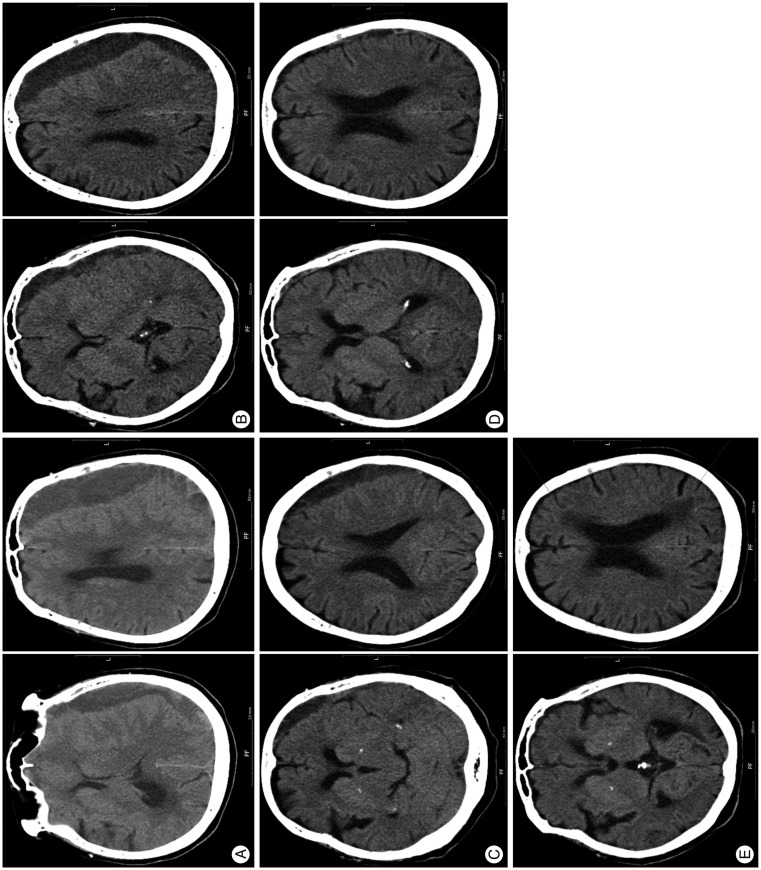J Korean Neurosurg Soc.
2015 Sep;58(3):301-303. 10.3340/jkns.2015.58.3.301.
Spontaneous Resolution of a Large Chronic Subdural Hematoma Which Required Surgical Decompression
- Affiliations
-
- 1Department of Neurosurgery, Chungbuk National University School of Medicine & Medical Research Institute, Cheongju, Korea. mslee@chungbuk.ac.kr
- KMID: 2191389
- DOI: http://doi.org/10.3340/jkns.2015.58.3.301
Abstract
- We report on a case of an 87-year-old woman who showed spontaneous resolution of a large chronic subdural hematoma which required surgical decompression. She had suffered from confused mentality and right side weakness of motor grade II for 10 days. The initial brain CT scan showed a 22 mm thick low density lesion located in the left fronto-temporo-parietal region with midline shift (12 mm) which required emergency decompression. However, because she and her family did not want surgery, she was followed up in the outpatient clinic. Five months later, follow up brain CT showed that the CSDH had disappeared and the patient became neurologically normal. The reasons for spontaneous resolution of CSDH remain unclear. We discuss the possible relation between mechanisms of physio-pathogenesis and spontaneous resolution of a large chronic subdural hematoma (CSH) in an elderly patient.
Keyword
MeSH Terms
Figure
Cited by 1 articles
-
Spontaneous Resolution of Chronic Subdural Hematoma : Close Observation as a Treatment Strategy
Hyung Chan Kim, Jung Ho Ko, Dong Soo Yoo, Sang-Koo Lee
J Korean Neurosurg Soc. 2016;59(6):628-636. doi: 10.3340/jkns.2016.59.6.628.
Reference
-
1. Glover D, Labadie EL. Physiopathogenesis of subdural hematomas. Part 2 : Inhibition of growth of experimental hematomas with dexamethasone. J Neurosurg. 1976; 45:393–397. PMID: 956875.2. Göksu E, Akyüz M, Uçar T, Kazan S. Spontaneous resolution of a large chronic subdural hematoma : a case report and review of the literature. Ulus Travma Acil Cerrahi Derg. 2009; 15:95–98. PMID: 19130348.3. Hohenstein A, Erber R, Schilling L, Weigel R. Increased mRNA expression of VEGF within the hematoma and imbalance of angiopoietin-1 and -2 mRNA within the neomembranes of chronic subdural hematoma. J Neurotrauma. 2005; 22:518–528. PMID: 15892598.
Article4. Horikoshi T, Naganuma H, Fukasawa I, Uchida M, Nukui H. Computed tomography characteristics suggestive of spontaneous resolution of chronic subdural hematoma. Neurol Med Chir (Tokyo). 1998; 38:527–532. discussion 532-533PMID: 9805896.
Article5. Kageyama H, Toyooka T, Tsuzuki N, Oka K. Nonsurgical treatment of chronic subdural hematoma with tranexamic acid. J Neurosurg. 2013; 119:332–337. PMID: 23641825.
Article6. Kawano N, Suzuki K. Presence of smooth-muscle cells in the subdural neomembrane. J Neurosurg. 1981; 54:646–651. PMID: 7229703.
Article7. Nakamura N, Ogawa T, Hashimoto T, Yuki K, Kobayashi S. Reevaluation on resolving subdural hematoma [(author's transl)]. Neurol Med Chir (Tokyo). 1981; 21:491–500. PMID: 6168960.8. Nomura S, Kashiwagi S, Fujisawa H, Ito H, Nakamura K. Characterization of local hyperfibrinolysis in chronic subdural hematomas by SDS-PAGE and immunoblot. J Neurosurg. 1994; 81:910–913. PMID: 7965121.
Article9. Park CK, Choi KH, Kim MC, Kang JK, Choi CR. Spontaneous evolution of posttraumatic subdural hygroma into chronic subdural haematoma. Acta Neurochir (Wien). 1994; 127:41–47. PMID: 7942180.
Article10. Parlato C, Guarracino A, Moraci A. Spontaneous resolution of chronic subdural hematoma. Surg Neurol. 2000; 53:312–315. discussion 315-317PMID: 10825513.
Article11. Santarius T, Kirkpatrick PJ, Kolias AG, Hutchinson PJ. Working toward rational and evidence-based treatment of chronic subdural hematoma. Clin Neurosurg. 2010; 57:112–122. PMID: 21280503.
- Full Text Links
- Actions
-
Cited
- CITED
-
- Close
- Share
- Similar articles
-
- Rapid Spontaneous Resolution of Acute Subdural Hematoma
- Bilateral Spontaneous Resolution of Chronic Subdural Hematoma: A Case Report
- Spontaneous Resolution of Chronic Subdural Hematoma in Children: Case Report
- Spontaneously Rapid Resolution of Acute Subdural Hemorrhage with Severe Midline Shift
- Rapid Spontaneous Resolution of Contralateral Acute Subdural Hemorrhage Caused by Overdrainage of Chronic Subdural Hemorrhage


